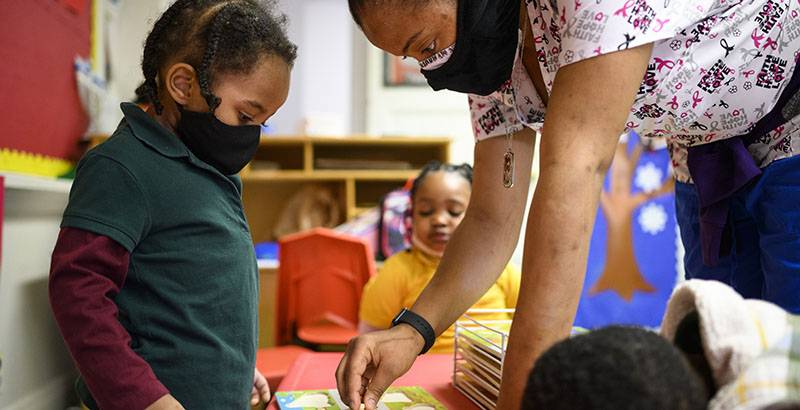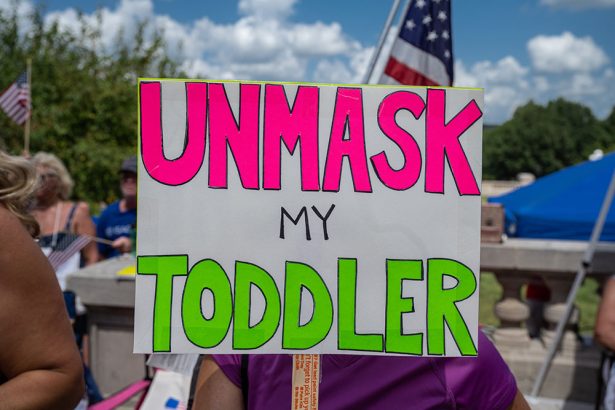Kids Wearing Masks Reduces Child Care Center Closures, Year-Long Yale Study Finds

Get stories like these delivered straight to your inbox. Sign up for The 74 Newsletter
Child care centers in which children wear masks are less likely than others to shut down because of COVID-19 outbreaks, according to what’s believed to be the first large-scale, year-long study of child masking in the U.S.
Conducted by researchers at Yale University, the study — involving more than 6,600 center- and home-based child care providers — showed that masks on children were associated with a 13- to 14 percent reduction in closures, while social distancing of 6 feet reduced the chances of closure by just 7 percent.
With young children still not eligible for vaccinations — and shots for those under 5 possibly still months away — the study supports experts’ recommendations that children 2 and up wear masks, especially with Omicron still causing frequent outbreaks, the authors wrote in an American Medical Association journal.
At a time when masking continues to incite protests, the findings, they said, “have important public health policy implications for families that rely on child care to sustain employment.” While the spike in cases due to Omicron has led to staffing shortages in centers, masking, the researchers added, can keep programs from having to close.
COVID-19’s impact on child care has had serious ramifications for the nation’s economy and families with young children. Thousands of mothers left the workforce when their children’s programs shut down. About 3 percent of child care centers failed to reopen after lockdowns, according to one analysis, and many young children lost an important source of playtime and language development.
But requiring young children over 2 to wear masks, as the Centers for Disease Control and Prevention currently recommends, is arguably even more controversial than such mandates are for kids in kindergarten and beyond. Opponents argue the masks make it hard for young children to recognize facial expressions and develop language skills, while others say those concerns are unfounded.
“We know children as young as 2 can safely and consistently wear masks if adults make that a routine expectation,” said Dr. Dean Blumberg, a pediatric infectious disease specialist at the University of California, Davis. He said masks may soon become optional as spring and summer approach, but added it’s important to remember why masks were recommended in the first place. “This was a completely novel virus that nobody had any immunity to,” he said.
The Yale study is different from most because it asked teachers about their masking practices in the spring of 2020 and followed up with the same teachers a year later, said Walter Gilliam, a child psychiatry and psychology professor at Yale and co-author of the paper.
It was also “a much larger study than most and takes into account many different types of programs in a wide variety of communities,” he said.
Policing mask use
The results, however, come as the COVID-related restrictions of the past two years have started to ease. Some states, for example, no longer recommend contact tracing.
In a Tuesday Washington Post op-ed, three physicians wrote that schools should begin to phase out mask mandates. The CDC’s latest guidance, which describes the benefits of upgraded masks, such as N95s, they wrote, offers a “pathway to compromise” in which those who are at higher risk protect themselves.
“Time and energy that staff spend policing mask use is far better spent on teaching and supporting children,” they wrote, also citing research that summarizes potential impacts of masks on young children’s development, particularly those that might have hearing loss.
The Yale paper addresses concerns that masks may inhibit children’s social and speech skills. The data is “very mixed and any negative impacts on children reading social cues is very small,” Gilliam said. “It’s COVID-19 that’s harmful, not the masks that prevent its spread.”
Blumberg at the University of California added that young children are not with masked adults all of the time and have “plenty of opportunities to develop these language skills and look at people’s lips moving.”
Even so, mask opponents are unlikely to be persuaded to drop their objections, noting that the World Health Organization generally recommends against mask use for children under 5.
“The harmful effects are amplified with young children,” said Sharon McKeeman, founder of Let Them Breathe, a California advocacy group that sued the state over its mask requirement in schools and is backing preschools and child care centers that defy the state’s indoor mask requirement. “Child care providers are starting to stand up for their rights and Let Them Breathe is here to support them.”

‘Always trying to catch up’
California still has a strict indoor mask mandate that includes child care centers. New York, where a judge restored the state’s mandate this week, is another. But in most cases, “parents likely choose programs that align with their beliefs with respect to mask wearing,” because child care centers are generally private businesses and not run by public boards like schools, said Lynette Fraga, CEO of Child Care Aware, a nonprofit that advocates for child care policies and supports local efforts to help families find care.
She noted that while opinions on masking in child care settings are as varied as they are in K-12, requiring masks is relatively inexpensive compared to other mitigation strategies like upgrading ventilation systems or social distancing, which can require more staff and smaller class sizes.
The Yale study showed that in the early months of the pandemic, only 9 percent of centers and child care homes in the sample required children to wear masks, likely representing “highly vigilant programs.” the authors wrote. A year later, about a third of the programs had a mask policy for children.
One factor that contributes to the pushback against masking children — whether it’s in child care or K-12 — is that families rarely know when the requirement will be lifted, said Benjamin Linas, a Boston University epidemiologist,
With Omicron still prevalent, he agrees that both schools and child care centers should currently require masks as much as possible. Dr. Thomas Murray, the lead author of the Yale study, noted the increased rate of child hospitalizations associated with Omicron. At the beginning of January, an average of 672 children were being admitted to the hospital each day — a pandemic record.
But Linas said families need to know upfront what’s triggering masking rules and what conditions would allow such requirements to lapse. He co-authored a paper last year that includes a tool to guide districts in making such calls. The same process could be used in programs for young children, he said.
Public health and district officials “typically do not make the goals of masking policy clear,” he said, “and so the policies are inherently stagnant and always trying to catch up.”
Get stories like these delivered straight to your inbox. Sign up for The 74 Newsletter

;)
